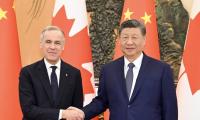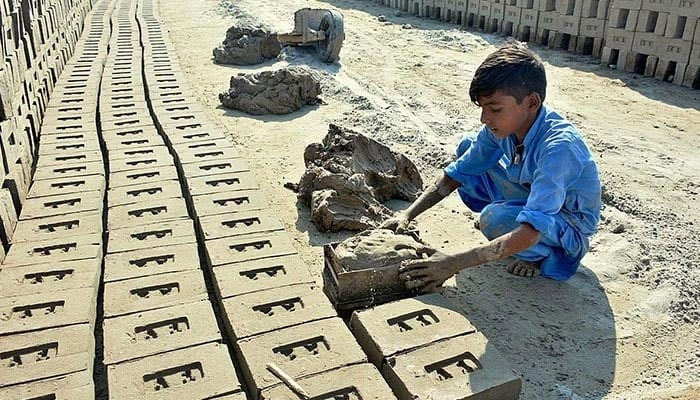Steps to end forced labour discussed
LAHORE : Forced labour, a crime under Pakistani law and a grave violation of human rights according to ILO, continues to plague approximately 3.4 million individuals in Pakistan, constituting more than 10 percent of the global total of 28 million victims.
Particularly concerning is the vulnerability of migrant workers, who are three times more likely to fall into forced labour compared to non-migrants. With over 6.5 million Pakistanis seeking employment abroad through legal channels in the last decade, predominantly in Gulf countries, the issue demands urgent attention.
Addressing this pressing concern, the ILO, in collaboration with the US Department of Labour (USDOL), organised a two-day training workshop here under the auspices of the BRIDGE project—an initiative aimed at eradicating forced labour and promoting equitable labour practices—focused on equipping journalists with the requisite knowledge and skills to effectively report on forced labour and fair recruitment issues.
A diverse cohort of 35 journalists representing various media platforms participated in the workshop.
Dr Faisal Iqbal, the national project coordinator at ILO, emphasised the pivotal role of media in raising public awareness regarding forced labour and advocating for fair recruitment practices.
‘Media can be key influencers in shaping public perceptions about forced labour and labour migration,’ Dr Iqbal remarked, expressing concern over the prevalence of forced labour in Pakistan affecting an estimated 3.4 million individuals.
Dr Iqbal further elucidated the objectives and significance of ‘The Bridge Project,’ emphasising the importance of accurate reporting on forced labour and fair recruitment.
He delineated the 11 indicators recognised by the ILO globally to identify forced labour, including power abuse, deception, movement restrictions, isolation, physical and sexual violence, wage retention, debt bondage, abusive working and living conditions, and excessive overtime.
-
 Canada And China Trade Deal: All You Need To Know About The New Agreement
Canada And China Trade Deal: All You Need To Know About The New Agreement -
 Tyler Hilton, Megan Park Call It Quits After 10 Years Of Marriage
Tyler Hilton, Megan Park Call It Quits After 10 Years Of Marriage -
 Prince Harry’s Fears Turn Concerning As Archie, Lilibet Slip Too Far Out Of Reach: ‘Their Too American’
Prince Harry’s Fears Turn Concerning As Archie, Lilibet Slip Too Far Out Of Reach: ‘Their Too American’ -
 Former Nickelodeon Star Kianna Underwood Dies At 33 In Tragic Hit-and-run
Former Nickelodeon Star Kianna Underwood Dies At 33 In Tragic Hit-and-run -
 Prince Harry Risks Straining Marriage To Make Archie, Lilibet Make Emotional Demand Of Meghan
Prince Harry Risks Straining Marriage To Make Archie, Lilibet Make Emotional Demand Of Meghan -
 Sarah Ferguson’s Pal Reveals What She Really Thinks Of Beatrice, Eugenie Choosing A Royal Christmas
Sarah Ferguson’s Pal Reveals What She Really Thinks Of Beatrice, Eugenie Choosing A Royal Christmas -
 North West Raps About Piercings, Tattoos And Skipping School In New Song
North West Raps About Piercings, Tattoos And Skipping School In New Song -
 Teddi Mellencamp Shares Hopeful Health Update Amid Cancer Battle: 'Cloud Is Lifting'
Teddi Mellencamp Shares Hopeful Health Update Amid Cancer Battle: 'Cloud Is Lifting' -
 Prince William Makes Clear The Conditions He Has For Meeting Prince Harry
Prince William Makes Clear The Conditions He Has For Meeting Prince Harry -
 Sara Foster Slams Age Gap Relationship After 'blah' George Clooney Date
Sara Foster Slams Age Gap Relationship After 'blah' George Clooney Date -
 Jennifer Garner Recalls Enduring Ben Affleck’s Intense Beyoncé ‘Halo’ Phase
Jennifer Garner Recalls Enduring Ben Affleck’s Intense Beyoncé ‘Halo’ Phase -
 Prince Harry’s Mental Health Ends Up At Stake As Meghan Moves Him To 'second Fiddle'
Prince Harry’s Mental Health Ends Up At Stake As Meghan Moves Him To 'second Fiddle' -
 Bradley Cooper On Who His Mother Thinks Is The World’s Best Actor
Bradley Cooper On Who His Mother Thinks Is The World’s Best Actor -
 Meghan Markle Offers Glimpse Into Intimate Dance Moment With Harry Amid Split Rumors
Meghan Markle Offers Glimpse Into Intimate Dance Moment With Harry Amid Split Rumors -
 Jon Bon Jovi Joins The Viral 2016 Throwback Trend With Nostalgic Photos
Jon Bon Jovi Joins The Viral 2016 Throwback Trend With Nostalgic Photos -
 Kate Middleton Hailed For Her Lack Of ‘obligation’ As Well As Altruistic, Selfless Qualities
Kate Middleton Hailed For Her Lack Of ‘obligation’ As Well As Altruistic, Selfless Qualities




